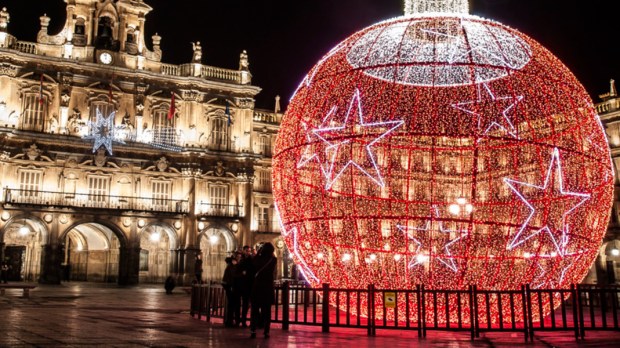In the United States, families seem to be as likely to spend Christmas Eve snagging online shopping deals as they do caroling. For better or for worse — okay, for worse — consumerist flurry sometimes seems to define the season more than generosity and togetherness. To top it off, a Bloomberg survey found that only slightly more than half of American employers give their employees Christmas Eve off. And some employees, no matter how much they wish otherwise, simply cannot afford to take unpaid leave. But, for the Americans who are lucky enough to have the evening off from work, Christmas Eve can also be a cherished time to take comfort in tradition; time for silent reflection at a Midnight Mass, or laughing by the fire with loved ones.
So if the consumer craze here in the U.S. has you feeling a little “bah humbug” this year, remember that there are so many beautiful, meaningful ways to observe this holy night. Just take a cue from one of these touching Christmas Eve traditions from across the globe — from Spain to Australia. Who knows? You might even discover a new family tradition worth bringing home.
1. Spain
https://www.instagram.com/p/BAMy4VNDQkw/
The Spanish kick off Christmas Eve (or la Nochebuena) with a massive meal with their loved ones. The meal often centers around turkey, lamb, or seafood, depending on the region. But the night doesn’t end there. Attending Midnight Mass (Misa del Gallo) is the standard for the country’s Catholics. The Spanish name translates to “The Mass of the Rooster” since Baby Jesus was thought to have been born on the unusual night a rooster crowed. Traditional Spanish music emboldened with the guitar, tambourine, zambomba (a type of drum), and the carraca (a type of noisemaker) almost certainly accompany the service.
In his article for The Telegraph‘s “Ex-pat Life” series, writer Alan Parks remarked at how “much less commercial” Spanish Christmas appeared to him than what he knew in his native Britain. “It is not usual for the streets to be decorated with bright lights till the first week of December, and people will decorate their homes for the second half of the month,” he writes. “This will involve a Christmas tree, although often small, and also a belén, a small nativity scene, which will always include Mary, Joseph and Jesus, as well as the three kings. At this time of year, many different characters can be purchased to make your belén unique. We have seen farmers with animals, blacksmiths, and all sorts of other figures.”
2. Germany
German Christmas is often cited as our main inspiration for American Christmas traditions (the tree, the Advent calendar, many traits for the modern Santa Claus).
Lashelle Johnson, an American woman whose mother is from Germany, says that she grew up learning all about German Christmas Eve from her mother’s side of the family: “[They] wouldn’t bring the tree home until the 24th and they would decorate it that day,” she said. “They ate Wiener mit Kartoffelsalat [sausage and potato salad] until 6 p.m. because that’s when they had to be out of the living room so Christkindl [the Christ Child] could come.”
Some German families spend Christmas Eve reading the Bible and singing traditional Christmas songs, as well. Christmas Eve is also the main night that family members exchange gifts with one another.
3. Poland
“We always open presents Christmas Eve, but only as soon as we see can see the first star in the evening sky,” says Katherine Brown, an American woman whose mother is from Poland. Rather, the emphasis for Polish families is on enjoying a family meal and making nods to Baby Jesus.
“We eat a very traditional ‘meager’ meal of borscht, uszka (mushroom dumplings), fish, and a few other items but those were core,” she says. “Also, my family always puts hay or grass under the table cloth to represent the manger, and set an extra seat at the table with food and everything to represent Jesus or in case a traveler shows up.”
But the traditions don’t stop there: “We also always have a piece of Eucharist [a large unconsecrated host with special designs embossed on it —ed.] that was blessed in Poland,” she says. “We each have a piece of it and take a moment with each member of the family to break a piece off of each other’s Eucharist, eat it, hug and wish each other good blessings.”
4. Mexico
Christmas Eve also is called la Nochebuena in Mexico. Roast pork is often the main course for the evening, but cuisine varies across the country. “In Mexico, dinner can include homemade tamales, atole, bacalao (cod) ala Vizcaina or romeritos en revoltijo (a dish made with Mexican greens) accompanied by buñuelos (small doughnuts) for dessert and ponche (punch) to toast,” writes Roxanne A. Soto of the Denver Post.
After enjoying dinner, attending Midnight Mass also is a tradition for many families. Churches are some of the central locations for poinsettias this time of year. The red flowers, whose Spanish name flor de Nochebuena means “Christmas Eve flower,” are native to Mexico and quite popular. According to a Mexican legend, there once was a little Mexican girl who was on her way to Christmas Eve Mass when she realized she didn’t have a present for Baby Jesus. She gathered a bunch of green poinsettias, which turned red when she arrived to the church. Now it’s common to bring poinsettias to church on Christmas Eve (if not earlier.)
5. Australia
Australia’s Christmas occurs during the summertime, so people tend to spend it outdoors. Some families will even go camping. On Christmas Eve, many Australians participate in an open-air caroling service by candlelight. According to the official Australian government website, this tradition began in 1937 thanks to radio announcer Norman Banks. Some of the caroling services are televised (and, yes, celebrities are involved), but others are much smaller and more localized. John Wheeler’s The Three Drovers is among the most beloved of Australian Christmas carols. Often, Christmas carols from other English-speaking countries will be sung, but with the words “snow” and “winter” replaced with something more summery.

Read more:
Are Your Christmas Traditions Fire or Ashes?

